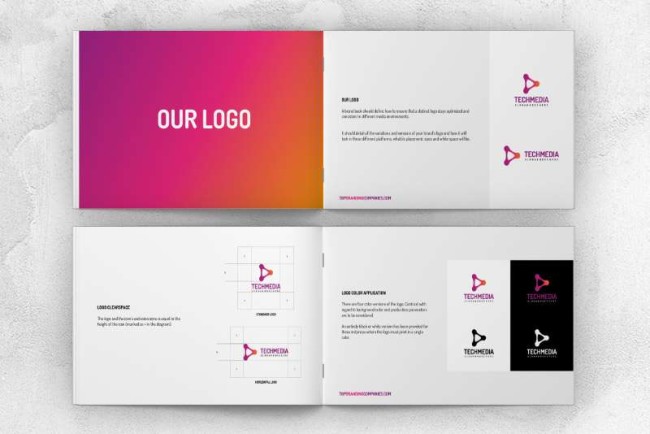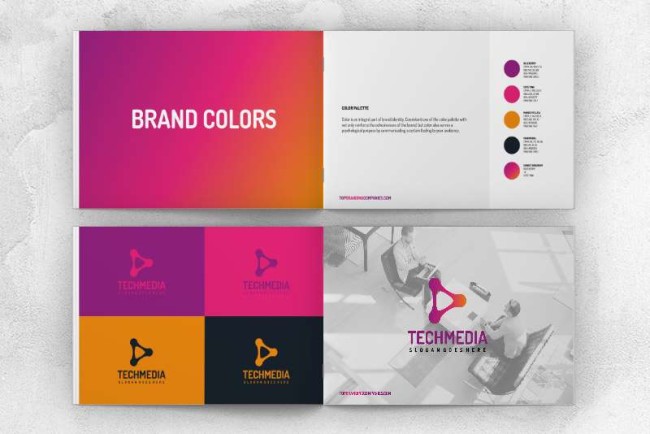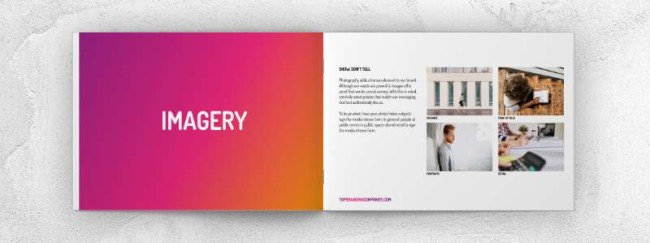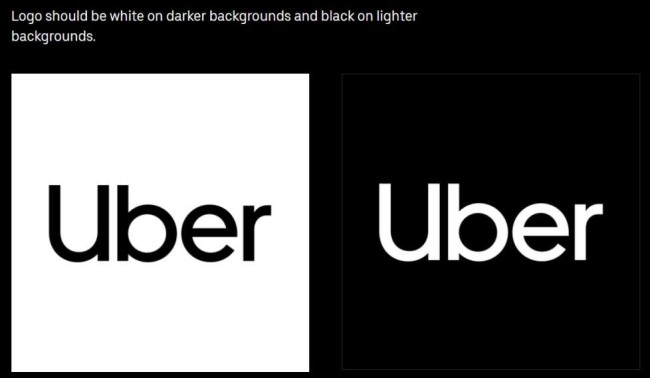how to create a beauty media directory
How To Create A Brand Book + 5 Brand Style Guide Examples From The Leading Tech, Retail & Beauty Companies
Last Updated: February 27, 2020
- 70,696

Did you know that consistent branding produces 23% more revenue on a yearly basis?
Surprisingly, despite the obvious advantages of the above fact, only one-fourth of businesses have formal branding guidelines such as a brand book (also known as brand style guide ) that they enforce consistently.
Having and enforcing a brand book's guidelines is helps businesses achieve the consistency necessary for brand awareness, recognition and, ultimately, loyalty.
Read on to find out:
- Benefits of creating a brand style guide
- A step-by-step guide to building your style guide
- 5 brand book examples by tech, retail and beauty giants
Agency description goes here
Agency description goes here
Agency description goes here
What Is A Brand Book Or A Style Guide?
A brand book, or a brand style guide, is a document that sets specific guidelines for perpetuating brand identity in all external and internal communications.
They most commonly focus on
- The use of logo
- The use of color
- Image and photo manipulation
- Tone of voice
The Key Elements Of A Brand Book
Typically, these type of books contain three main sections:
- About
- Visual guidelines
- Communication guidelines
1. About
In this section, you need to specify your mission, values and target audience.
Defining this right from the get-go gives context to the content that follows and adds logic to everything you or your partners plan to do using the brand style guide.
2. Visual Guidelines
In this section, you should list the following design:
- Logo : Its placement, variations for different platforms and channels, colors, size and proportions
- Colors : Primary and secondary colors as well its monochrome version
- Fonts : Corporate typography that are used in headlines and bodies of text in official documents
- Photography : Its style and guidelines used for consistent presentation
- Brandmark : Where to use it
- Other : Patterns, textures, graphics, icons
3. Communication Guidelines
This section of the brand style guide defines the following:
Language : the official language or languages in which a brand communicates with its audience
Style : formatting, technical and non-technical messaging
Tone of voice: professional, logical, emotional, humorous etc.
Social media presence: posting types, posting times, different social media styles
Emails : structure, signature and tone
Readability and grammar: types of sentences and its lengths, capitalization, numbers, abbreviations, acronyms
How To Create A Brand Style Guide
Businesses can create brand books only when they define their unique character and vision.
To do this, define the four components of your business:
- Vision and core values
- Brand mission
- Brand persona
- Target audience
Brand's visionand core values guide the brand and all business decisions. They point the company towards its long-term objectives such as gaining brand awareness , trust and customers' loyalty.
Answering the following questions can help determine your vision and values:
- How big do you want your company to get?
- Do you plan to branch out with products and services not currently offered?
- What kind of legacy do you want your business to leave behind?
Brand m ission must be devoid of any vague concepts and establish itself on the grounds of the following questions:
- What is your company's purpose and its reason for being?
- What is the difference it is trying to make?
Once you answer these, your business will be able to differentiate itself from the competition, inspire greater consumer engagement and hire the talent that fits the company's vision.
Both your mission and vision should be in the opening lines of the brand style guide, so as to underline the reasons why it is important for everyone to be on the same page with the following style rules.
Brand persona, or personality, is vital for getting the right tone of voice for messaging across all channels.
Consistent messaging that stems from a well-defined persona makes it easier for customers to connect and identify with your brand.
Brand can be thought about as a person with a list of traits you want it to have. Once you identify the collection of traits to incorporate into a persona, they can become a guide for the company's messaging.
Target audience is one of the most important things to define - and to do that, you need to ask yourself:
- What type of people do you want to use your products?
- Which people would you like to visit your site and subscribe to your newsletters?
- What are your audience's needs, wants and values - and how do you factor into them?
Knowing your market segment narrows down your audience's focus and allows you to tailor your message to very specific demographics.
What To Include In Brand Book's Style Guidelines?
1. Logo
A brand style guide should define how to ensure that a distinct logo stays optimized and consistent in different media environments.
It should detail all the variations and versions of your logo and how it will look in these different platforms, what its placement, sizes and white space will be.

2. Colors
It's standard practice to pick four or fewer main hues as your primary color palette.
This type of book should define when and how to use each color:
Which one is used for the text and which for the design elements?
Which color is for the logo, and which is for the background to make it "pop"?
Sometimes, these books also define the specific brand color names, color hexadecimal, RGB and CMYK values or a Pantone name and number, secondary and alternate colors.

3. Typography
Similarly, there should be a defined font style for both print and digital applications.
In your book, typography should cover how and when to use certain fonts, which typefaces are acceptable, as well as guidelines for additional styling, size, and use of color.
As pointed out by Mayven, most brands use one or two primary typefaces, a complementary typeface, and substitute typefaces.

4. Voice And Messaging
Your tone of voice needs to be consistent across all communication channels - email, social media, press releases, blog posts, ads, etc.
Your brand's voice should be aligned with its persona, mission, vision, values and target audience.
You can start by identifying words you like and don't like to be associated with.
Then, decide what type of language fits your persona and your target audience.
Go back to your list of adjectives describing your brand personality to come up with language that is on-brand.

5. Images
Apart from indicating whether you'll be using photos, illustrations and other types of graphics (as well as when and how you'll be using them), your brand book should also detail how to edit images, which colors to place them with, and any other design elements related to image use.
Collect inspiration from successful brands, particularly those that have similar brand messaging as yours.
You can also create a mood board with images that convey the feelings you want people to get when they interact with your brand.

6. Dos And Don't
Brand style guides that also include the things that marketers, designers, partners and advertisers shouldn't do - along with the things they should - are double helpful.
Having "Do" and "Don't" columns with specific items under each helps drive home the point and importance of adhering to branding requirements.
7. Other Specifics
Don't be afraid to be very specific about anything that you feel is necessary to be explained. The more details you have in your brand book, the better.
It could be helpful for everyone to include specific scenarios, case studies, visual aids and examples of use for different logos, imagery, tone of voice and colors.
If you want to have a different font used across different communication channels, demonstrate this in very specific examples of typeface for body copy, headlines and titles on all of these channels. This leaves no room for interpretations and uncertainties.
Why Should Businesses Create And Follow A Brand Style Guide?
The biggest advantage of having a brand guide book is that it gives your business consistency and cohesion.
Consistency in messaging and visual presentation sets your company's tone, personality and identity.
This, over a longer period of time, fosters trust and loyalty with the target audience. A design that is too varied can be confusingly inconsistent, which dilutes the brand identity and trustworthiness.
Besides presenting a uniform brand image to your target audience, a brand book can help establish and promote a unique corporate culture and identity, resulting in higher employee retention.
Brand Book Examples: How 5 Leading Consumer Brands Maintain Consistency In All Their Communication
Companies that have mastered the art of consistency have done so by following their very detailed brand style guides to the T.
Let's take a look at five of these companies whose brand books stand out and bring them business success.
Apple's Authorized Reseller Style Guide
The half-eaten apple is one of the most immediately recognizable logos in the world - but is merely a fraction of what makes this brand so memorable.
Appel's brand guidelines are made for internal use and for use by companies that promote Apple, in order to "reap the benefits of the Apple identity and contribute to its strength".
Its content spans using Apple channel signatures such as:
- Color
- Minimum clear space and minimum size
- Typography
- Avoiding signature mistakes
- Merchandise items
- Stationery guidelines and more
It also outlines reseller stores identity, using Apple assets and trademark and credit lines.

Samsung Mobile
Samsung is a brand that is quite diversified and consists of multiple subdivisions - each having its own set of standards.
Samsung Mobile's brand book outlines standards that define this brand and is an "evolving source for consistent communications across a wide audience of consumers and agencies".
The brand stylebook contains elements such as proof points and archetypes, that discuss visual standards through a range of specific examples, as well as Samsung's personality.
It also conveys:
- Logotypes
- Master logo
- Logo variations
- Device logos
- Campaign logos
- Color palette
- Typography
- UI elements
- Backgrounds
- The role of photography
- Tone
- Terminology
Besides these fairly standard features, Standard Mobile also has specific requirements when it comes to product presentation. Their brand book discusses requirements for device angles as well as poses and composition with devices.

Amazon
Online retailer company Amazon's brand usage guidelines emphasizes the importance of proper brand usage as one of the company's most valuable assets.
The firm allows advertisers to use Amazon branding elements within the requirements that are specified in the document. Also, advertisers must submit the material they intend to use to Amazon for approval.
Amazon's guidebook outlines:
- Call to Actions and Amazon text link CTAs that should conform to standards in typeface and sizing, graphical styling, color and .com usage
- Branded button CTAs
- Capitalization and punctuation
- Brand phrases
- Branding on and off Amazon site
- Logos and imagery
- Clear Space
- Icons and site elements
- Product imagery

Lancome
This personal care and beauty brand has a very brief brand style book that opens with an introduction and a story about a brand's longevity, values and mission.
Claiming their pivotal role in skincare innovation, the company sets the tone in these opening lines by citing its brand ambassadors and accessibility across the world as some of its strongest points.
The brand book moves on to define these elements as essential for its employees and marketing campaigns:
- Logo
- Brand colors
- Typography
Lancome's brand style guide is significantly more concise than most of other brands' on this list. The reason for this is that the mentioned elements don't vary too much across different channels and are quite uniform. Also, the dose of exclusivity is enhanced through this minimalistic approach which gives an air of luxury to a mass product.

Uber
World's number one ride-hailing app has a stylish brand book that contains nine core elements:
- Logo
- Color
- Composition
- Iconography
- Illustration
- Motion
- Photography
- Tone of Voice
- Typography
Each of those takes up its own section in the brand book and is very detailed in the way it explains how every core element should be constructed for consistency.
For instance, Uber specifies that its primary color, is its global association with the brand, is black. The company also defines a range of secondary and tertiary colors to be used in order to work for the black, in instances of alternate logo versions.
The brand book also contains guides on logo construction and clearspace, as well as its scale, placement and typeface.
Uber is very detailed in determining its unique tone of voice to be used across all touchpoints. They define consideration, simplicity and consistency as their messaging's key worth; as well as sounding optimistic, inviting and bold.

Brand Book Takeaways
Brand style book is very important for keeping your brand's identity consistent and distinctive. As your company grows, this document will help with keeping the larger number of employees on the same page with the requirements and standards of the business.
This ensures your brand sticks in your target audience's mind by always remaining faithful to your logo, colors, tone of voice, typography and other vital elements that constitute your business.
And as your business grows and matures, this will help to build a trustworthy and reliable experience for everyone who engages with it – which means more customers and more profits.
This is the ultimate guide to business branding.
READ IT HERE
how to create a beauty media directory
Source: https://www.designrush.com/trends/brand-book
Posted by: hughesthind1949.blogspot.com

0 Response to "how to create a beauty media directory"
Post a Comment